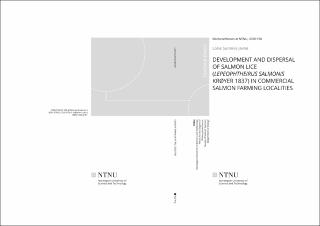| dc.contributor.author | Jevne, Lone Sunniva | |
| dc.date.accessioned | 2020-06-04T06:26:43Z | |
| dc.date.available | 2020-06-04T06:26:43Z | |
| dc.date.issued | 2020 | |
| dc.identifier.isbn | 978-82-326-4729-3 | |
| dc.identifier.issn | 1503-8181 | |
| dc.identifier.uri | https://hdl.handle.net/11250/2656444 | |
| dc.description.abstract | The development and dispersal of salmon lice (Lepeophtheirus salmonis) were studied in an intensive aquaculture production site in central Norway, practicing coordinated production cycles. The development of salmon lice on salmon in the localities were studied through three production cycles (2013-2018) by examining count data from the salmon farms themselves. Salmon lice was a more prominent problem the second year of the production cycle. However, in one of the production cycles, the numbers of adult female lice increased and remained at a similarly high numbers from the first summer. The area also showed a change from reliance on medical treatments to a higher proportion of mechanical treatments against salmon lice during the study period.
Possible hindrances of the dispersal of planktonic stages of salmon lice by biofouling on cage-nets or by lice skirts were studied through the last production cycle by investigating the densities of planktonic sea lice on the inside and outside of cages. For cages without lice skirts, the densities of planktonic sea lice were found to positively correlate with temperature the first and second year, and also with the abundance of adult female lice on farmed salmon during the second year of the production cycle. This pattern was similar for salmon cages equipped with lice skirts, except for the correlation with temperature, which was not significant the second year. There were more planktonic lice in periods with a high abundance of parasitic sea lice on the farmed salmon. Neither biofouling on the cage-net nor the presence of a lice skirt seemed to hinder the dispersion of the planktonic stages out of the salmon cages.
No evidence was found for sea lice utilising biofouling as a microhabitat, and in situ net cleaning did not affect the densities of planktonic sea lice. During fallowing, no planktonic lice of salmon lice or Caligus elongatus were found, and synchronised fallowing in this area was able to curb an escalating salmon lice situation. We also found evidence suggesting that stocking cleaner fish at 4% of salmon numbers or more can delay the time before a locality reaches 0.1 adult female lice per salmon. | en_US |
| dc.description.abstract | Norsk sammendrag: Utviklingen og spredning av lakselus (Lepeophtheirus salmonis) ble studert i et område i Midt-Norge, Frøya, med intensiv lakseproduksjon, og koordinerte produksjonssykluser. Utviklingen av lakselus på laksen ble studert gjennom tre produksjonssykluser (2013-2018) ved å undersøke telledata fra oppdretterne selv. Lakselus var et større problem i andre året av produksjonssyklusen. I en av produksjonssyklusene økte antallet voksne hunnlus allerede første sommeren og holdt seg på samme nivå resten av produksjonssyklusen. Det var et skifte i typen avlusninger som ble brukt, fra medisinske til en overvekt av mekaniske i løpet av studieperioden.
Tettheter av de planktoniske stadiene av lus, gjennom den siste produksjonssyklusen, og mulige hindre for spredning, som begroing på nøter eller luseskjørt, ble studert ved å undersøke tetthetene av planktoniske lus på innsiden og utsiden av merder. For merder uten luseskjørt ble det funnet ut at tetthetene av planktoniske lus korrelerte positivt med temperaturen første og andre året i produksjonssyklusen, men også med andelen voksne hunnlus på laksen andre året. Merder med luseskjørt fulgte de samme trendene, men korrelasjonen med temperatur var ikke signifikant andre året. Det var mer planktoniske lus når det var høyere andel av lus på laksen. Verken begroing på nøtene eller bruken av luseskjørt så ut til å hindre spredning av luselarver ut av merden.
Det ble ikke funnet noen indikasjoner på at lakselus kan bruke begroing som et mikrohabitat, og vasking av nøter forandret ikke tetthetene av planktoniske lus inne i merden. I løpet av brakkleggingsperioden ble det ikke funnet planktoniske lus av verken lakselus eller skottelus (Caligus elongatus), og en synkronisert brakklegging i dette området var i stand til å dempe en eskalerende lusesituasjon. Det ble funnet indikasjoner som tilsier at innblanding av rensefisk over 4% kan forlenge tiden før et anlegg når 0,1 voksne hunnlus per laks. | en_US |
| dc.language.iso | eng | en_US |
| dc.publisher | NTNU | en_US |
| dc.relation.ispartofseries | Doctoral theses at NTNU;2020:190 | |
| dc.relation.haspart | Paper 1: Jevne, Lone Sunniva; Reitan, Kjell Inge. How are the salmon lice (Lepeophtheirus salmonis Krøyer, 1837) in Atlantic salmon farming affected by different control efforts: A case study of an intensive production area with coordinated production cycles and changing delousing practices in 2013–2018. Journal of Fish Diseases 2019 s. 1-14 | en_US |
| dc.relation.haspart | Paper 2: Jevne, L. S., Øvrelid, M. S., Hagemann, A., Bloecher, N., Steinhovden, K. B., Båtnes, A. S., Olsen, Y., Reitan, K. I. (2020). Biofouling on salmon pen nets and cleaner fish shelters does not harbour planktonic stages of sea lice. | en_US |
| dc.relation.haspart | Paper 3: Jevne, L. S., Guttu, M., Båtnes, A. S., Olsen, Y., Reitan, K. I. (2020). Planktonic sea lice (Lepeophtheirus salmonis and Caligus elongatus) densities at a commercial Atlantic salmon (Salmo salar) farms in Norway, through a production cycle. | en_US |
| dc.title | DEVELOPMENT AND DISPERSAL OF SALMON LICE (LEPEOPHTHEIRUS SALMONIS KRØYER 1837) IN COMMERCIAL SALMON FARMING LOCALITIES | en_US |
| dc.type | Doctoral thesis | en_US |
| dc.subject.nsi | VDP::Mathematics and natural science: 400::Basic biosciences: 470 | en_US |

